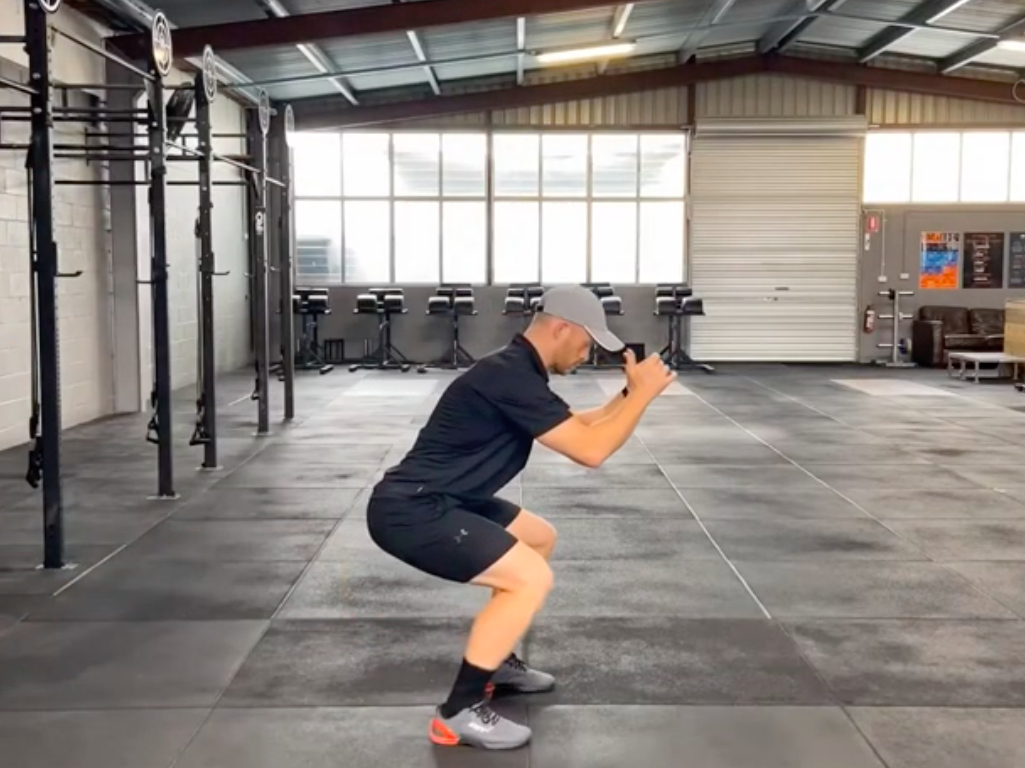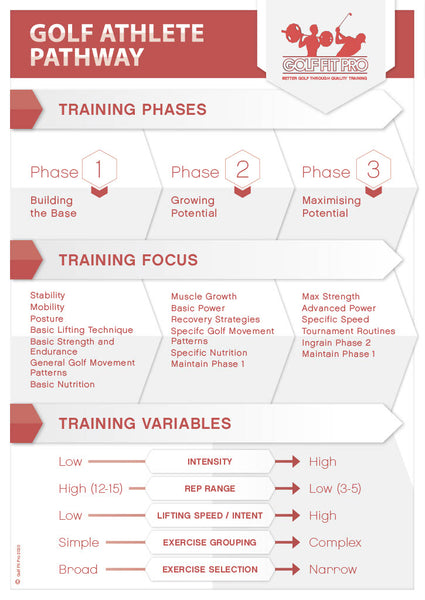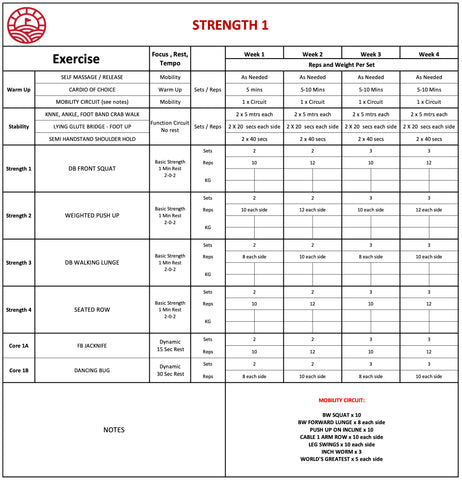Instruction
The Golf Athlete Pathway

The Golf Athlete Pathway represented in the image below is essentially my long term approach to training golfers, boiled down to a 1 page document. It aims to give a broad overview of the journey that an aspiring elite player would take when training under my supervision or guidance.

I realize that the majority of you reading this article are not aspiring elite players, and might well be happy just doing a really good job of Phase 1, thereby reaping the rewards of a body that moves better, feels healthier, has a reduced risk of injury and a greater potential to execute quality golf shots.
Whether you are dreaming of playing on tour, or just playing without getting hurt, I hope that my explanation of the 3 training phases and examples of workouts and exercises will give you a thorough understanding of how I train golfers.

Phase 1 – Building the Base
The first phase is focused on setting up a foundation of solid lifting technique and sorting out mobility, stability, and posture issues, whilst developing good exercise and nutrition habits.
Training Focus
Stability – Training key muscle groups to stabilise and balance the body in both gym movements and golf swing. Key areas of focus are foot / ankle, hip, core, shoulders, neck / head.
Mobility – Increasing range of motion in joints that require more movement.
Posture – Developing awareness of neutral spine position, understanding individual postural traits, training the deep muscle system to automatically hold good postural positions.
Basic Lifting Technique – Mastering the fundamentals of squat, lunge, push, pull, rotate and brace.
Basic Strength and Muscular Endurance – Improving ability to move bodyweight and light resistance efficiently, conditioning muscles to tolerate and recover from training loads.
General Golf Movement Patterns – Learning how to rotate efficiently at the hips and T-Spine. Developing basic scapular control and applying it to golf swing mechanics.
Basic Nutrition – developing understanding of the importance of whole unprocessed foods, achieving a balance of macro nutrients (carbs, fats, proteins) and learning the basic skills of food preparation.
Training Variables
Intensity – Relatively light loads, less than 50% of max. Using bodyweight, resistance bands, kettlebells, dumbbells.
Rep Range – fairly high, generally in the 10-15 range.
Lifting Speed / Intent – slow and controlled, focusing on technique.
Exercise Grouping – quite simple, when exercises are paired together it’s generally different muscle groups and movements (e.g. squat and push for example)
Exercise Selection – broad, aiming to learn many variations of squat, lunge, push, pull in order to help develop physical literacy.
Phase 1 Workout Example

Phase 1 Exercise Examples
Phase 2 – Growing Potential
Now we have mastered the basics, in Phase 2 it’s time to get bigger and stronger, whilst paying more specific attention to movement patterns, nutrition and recovery.
Training Focus
Muscle Growth – increasing muscle mass throughout the body, with particular focus on legs and back.
Basic Power – learning how to move light loads fast, lots of jumping and throwing.
Recovery Strategies – understanding importance of post training and play recovery such as self massage, hot/cold contrast, cold water immersion, stretching etc.
Specific Golf Movement Patterns – collaborating with the golf coach to help ingrain body movement that coach wants to see implemented or ingrained in the golf swing.
Specific Nutrition – consulting with nutritionist / dietician to deliver individual nutrition plans and recommendations on supplements.
Training Variables
Intensity – starting to lift heavier loads, around 70% of maximum
Rep Range – 8 to 12 for most exercises
Lifting Speed / Intent – still quite slow, generally using 2-0-2 tempo (2 seconds up – no pause – 2 seconds down).
Exercise Grouping – starting to get more complex, often grouping exercises that use the same muscle group or movement.
Exercise Selection – Getting narrower, with a focus on gradually increasing volume on key exercises.
Phase 2 Workout Example

Phase 2 Exercise Examples
Phase 3 – Maximising Potential
This is the final phase of the pathway, aiming to transfer the physical gains developed in the first 2 phases to elite performance.
Training Focus
Max Strength – Training neural system and muscle contraction co-ordination to increase max force output.
Advanced Power – Focusing on vertical and rotational power production. Jumping, throwing and rotating as fast as possible with medium to heavy loads.
Specific Speed – Aiming for increases in club head speed, often working together with the coach to ensure there is no detriment to technique.
Tournament Routines – Combining training, warm up, recovery, nutrition and hydration habits into a repeatable routine for tournament weeks.
Training Variables
Intensity – getting quite high now, lifting heavy loads at close to maximum effort.
Rep Range – generally quite low, looking at 3-5 for major lifts and 8-10 for supporting exercises.
Lifting Speed / Intent – aiming to move everything as fast as possible in concentric phase (when the muscles are shortening – up phase in a squat or bench press for example).
Exercise Grouping – more complex now, often combining exercises in supersets or mini circuits.
Exercise Selection – becoming much more narrow, focusing on repeating key movements with heavier loads. Still some variety in supporting exercises.
Phase 3 Workout Example

Phase 3 Exercise Examples
If you are interested in progressing along the Golf Athlete Pathway, then check out the services on offer at Golf Fit Pro
- LIKE33
- LEGIT7
- WOW1
- LOL1
- IDHT0
- FLOP3
- OB0
- SHANK8
Instruction
Clement: Laid-off or perfect fade? Across-the-line or perfect draw?

Some call the image on the left laid off, but if you are hitting a fade, this could be a perfect backswing for it! Same for across the line for a draw! Stop racking your brain with perceived mistakes and simply match backswing to shot shape!
- LIKE0
- LEGIT0
- WOW0
- LOL0
- IDHT0
- FLOP0
- OB0
- SHANK1
Instruction
The Wedge Guy: The easiest-to-learn golf basic

My golf learning began with this simple fact – if you don’t have a fundamentally sound hold on the golf club, it is practically impossible for your body to execute a fundamentally sound golf swing. I’m still a big believer that the golf swing is much easier to execute if you begin with the proper hold on the club.
As you might imagine, I come into contact with hundreds of golfers of all skill levels. And it is very rare to see a good player with a bad hold on the golf club. There are some exceptions, for sure, but they are very few and very far between, and they typically have beat so many balls with their poor grip that they’ve found a way to work around it.
The reality of biophysics is that the body moves only in certain ways – and the particulars of the way you hold the golf club can totally prevent a sound swing motion that allows the club to release properly through the impact zone. The wonderful thing is that anyone can learn how to put a fundamentally sound hold on the golf club, and you can practice it anywhere your hands are not otherwise engaged, like watching TV or just sitting and relaxing.
Whether you prefer an overlap, interlock or full-finger (not baseball!) grip on the club, the same fundamentals apply. Here are the major grip faults I see most often, in the order of the frequency:
Mis-aligned hands
By this I mean that the palms of the two hands are not parallel to each other. Too many golfers have a weak left hand and strong right, or vice versa. The easiest way to learn how to hold the club with your palms aligned properly is to grip a plain wooden ruler or yardstick. It forces the hands to align properly and shows you how that feels. If you grip and re-grip a yardstick several times, then grip a club, you’ll see that the learning curve is almost immediate.
The position of the grip in the upper/left hand
I also observe many golfers who have the butt of the grip too far into the heel pad of the upper hand (the left hand for right-handed players). It’s amazing how much easier it is to release the club through the ball if even 1/4-1/2″ of the butt is beyond the left heel pad. Try this yourself to see what I mean. Swing the club freely with just your left hand and notice the difference in its release from when you hold it at the end of the grip, versus gripping down even a half inch.
To help you really understand how this works, go to the range and hit shots with your five-iron gripped down a full inch to make the club the same length as your seven-iron. You will probably see an amazing shot shape difference, and likely not see as much distance loss as you would expect.
Too much lower (right) hand on the club
It seems like almost all golfers of 8-10 handicap or higher have the club too far into the palm of the lower hand, because that feels “good” if you are trying to control the path of the clubhead to the ball. But the golf swing is not an effort to hit at the ball – it is a swing of the club. The proper hold on the club has the grip underneath the pad at the base of the fingers. This will likely feel “weak” to you — like you cannot control the club like that. EXACTLY. You should not be trying to control the club with your lower/master hand.
Gripping too tightly
Nearly all golfers hold the club too tightly, which tenses up the forearms and prevents a proper release of the club through impact. In order for the club to move back and through properly, you must feel that the club is controlled by the last three fingers of the upper hand, and the middle two fingers of the lower hand. If you engage your thumbs and forefingers in “holding” the club, the result will almost always be a grip that is too tight. Try this for yourself. Hold the club in your upper hand only, and squeeze firmly with just the last three fingers, with the forefinger and thumb off the club entirely. You have good control, but your forearms are not tense. Then begin to squeeze down with your thumb and forefinger and observe the tensing of the entire forearm. This is the way we are made, so the key to preventing tenseness in the arms is to hold the club very lightly with the “pinchers” — the thumbs and forefingers.
So, those are what I believe are the four fundamentals of a good grip. Anyone can learn them in their home or office very quickly. There is no easier way to improve your ball striking consistency and add distance than giving more attention to the way you hold the golf club.
More from the Wedge Guy
- The Wedge Guy: Golf mastery begins with your wedge game
- The Wedge Guy: Why golf is 20 times harder than brain surgery
- The Wedge Guy: Musings on the golf ball rollback
- LIKE87
- LEGIT13
- WOW6
- LOL1
- IDHT0
- FLOP4
- OB1
- SHANK8
Instruction
Clement: Stop ripping off your swing with this drill!

Not the dreaded headcover under the armpit drill! As if your body is defective and can’t function by itself! Have you seen how incredible the human machine is with all the incredible feats of agility all kinds of athletes are accomplishing? You think your body is so defective (the good Lord is laughing his head off at you) that it needs a headcover tucked under the armpit so you can swing like T-Rex?
- LIKE0
- LEGIT2
- WOW2
- LOL0
- IDHT0
- FLOP0
- OB0
- SHANK2
-

 19th Hole2 weeks ago
19th Hole2 weeks agoDave Portnoy places monstrous outright bet for the 2024 Masters
-

 19th Hole5 days ago
19th Hole5 days agoJustin Thomas on the equipment choice of Scottie Scheffler that he thinks is ‘weird’
-

 19th Hole3 weeks ago
19th Hole3 weeks agoTiger Woods arrives at 2024 Masters equipped with a putter that may surprise you
-

 19th Hole4 days ago
19th Hole4 days ago‘Absolutely crazy’ – Major champ lays into Patrick Cantlay over his decision on final hole of RBC Heritage
-

 19th Hole2 weeks ago
19th Hole2 weeks agoTwo star names reportedly blanked Jon Rahm all week at the Masters
-

 19th Hole2 weeks ago
19th Hole2 weeks agoReport: LIV Golf identifies latest star name they hope to sign to breakaway tour
-

 19th Hole2 weeks ago
19th Hole2 weeks agoNeal Shipley presser ends in awkward fashion after reporter claims Tiger handed him note on 8th fairway
-

 19th Hole1 week ago
19th Hole1 week agoBrandel Chamblee has ‘no doubt’ who started the McIlroy/LIV rumor and why
















benymo
Dec 18, 2020 at 12:17 pm
or I could just get some speed sticks
Acemandrake
Dec 19, 2020 at 1:31 pm
…along with a healthy diet